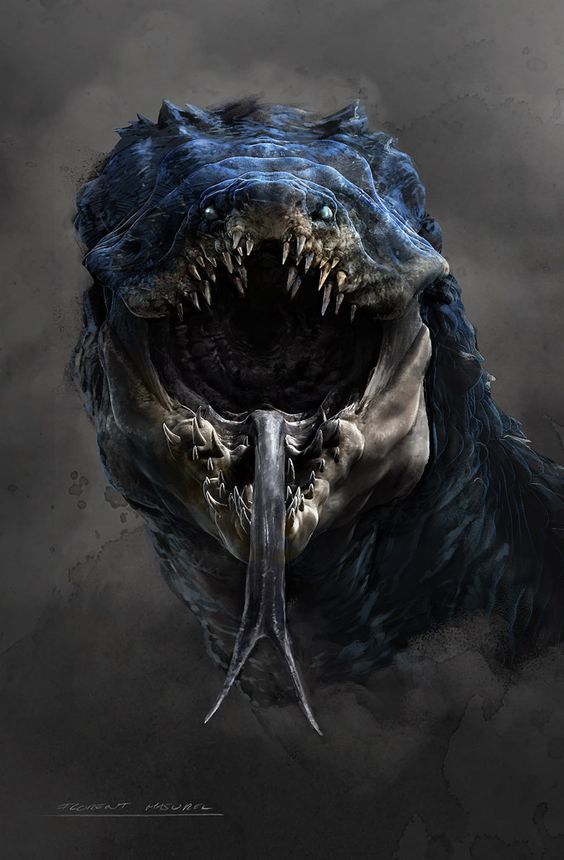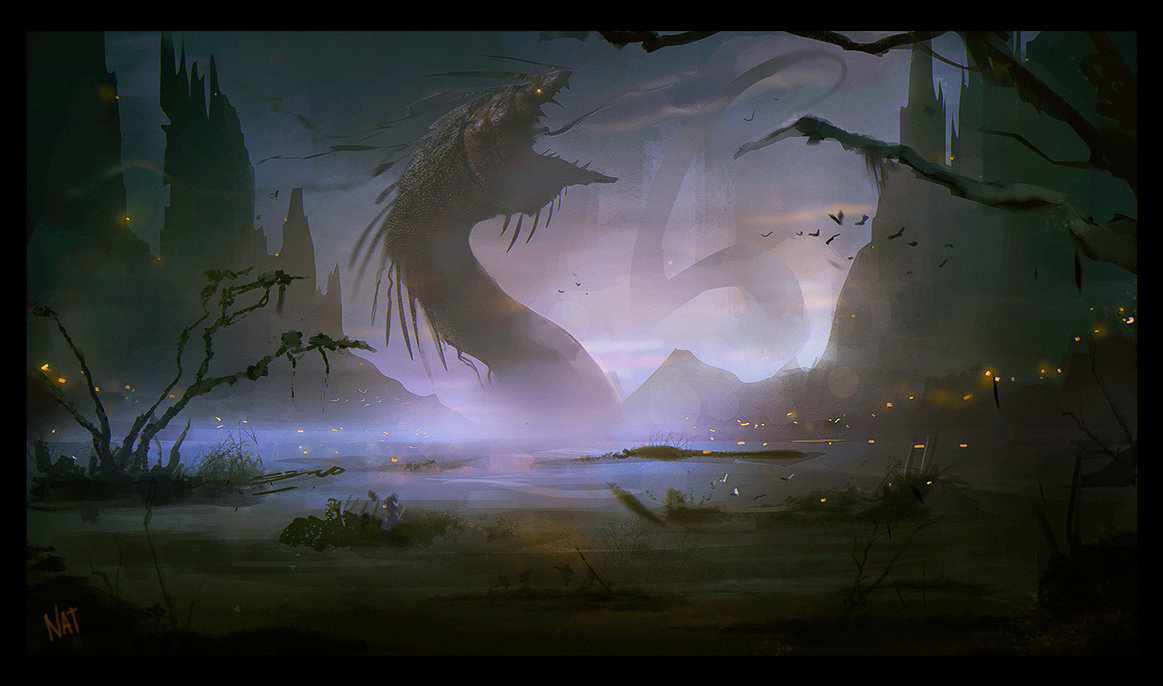Valdra
"And when the Dread Dragoness that encircles all the realms is free, you shall weep for the age of mortals will be forever over and forgotten" — The Black Edda
The Dread Dragoness
Valdra is an Elder Being and Goddess of the Unspoken Six. Like many Great Old Ones, Valdra appears in mythology across Holos and is widely considered be the one who brings about the end of creation itself. She is the goddess of serpents, monsters, unnatural sentience, bestial fury, earthquakes, caves, and the chromatic dragons. During the War of the Dawn, she was roused from her slumber at the bottom of the Primordial Sea and rose up to destroy all things. It was only through the creation of the Heavenly Council and their champion, the god Oheilion, that the Dread Dragoness was able to be stopped. Today, it is believed that Valdra lives, trapped within the Material Plane's Underdark, where she awaits her release. Upon being freed in the eschatological Twilight Era, she will participate in the Last War of mortals and gods before ending the period with the Final Doom of All Things.
Divine Domains
Valdra is the goddess of serpents, monsters, unnatural sentience, poison, venom, the yuan-ti and the chromatic dragons. Her divine domains are Nature and Death.
Holy Books & Codes
Valdra's followers hold no sacred scriptures in wide circulation. A few codices have been recovered from yuan-ti temples but they have yet to be decoded or catalogued by any of Holos's research institutions.
The Varskogans of Varangia have a detailed prophecy attributed to the giant god Jötu called the Black Edda. It recounts the signs and events that will lead to Valdra's release and to the Final Doom that follows her liberation.
Divine Symbols & Sigils
Valdra's divine symbol is a wide eye with a slitted pupil or five rings of black, white, red, blue, and green. Her sacred colors are brown and grey or when associated with her chromatic dragons, black, white, red, blue, and green.
Divine Goals & Aspirations
To bring about the Final Doom by freeing the goddess from her imprisonment beneath the Underdark.
Physical Description
General Physical Condition
Valdra is generally depicted as a great serpent so large she encircles the whole realm of Holos. Sometimes she is shown just as an unending maw of razor sharp teeth. Regardless, she is always considered immense beyond mortal comprehension and indeed more akin to a force of nature than to a sentient being.
Mental characteristics
Personal history
Valdra is not truly a goddess, but a Great Old One, a beast that fell to the Primordial Sea during the Time Before The Dawn. After falling, she slept in the Primordial Sea while the young gods of the Heavenly Council warred first against the Primordial Titans themselves and then against the Fallen Gods Zaguna, Deverin, and Rheseldar. This final conflict was so cataclysmic that it roused Valdra from her slumber and the Great Old One fought with the beleaguered Heavenly Council. The Council tried unsuccessfully to drive her from the world. The resulting devastation led the Council to decide to create a new being for the express purpose of destroying the Dread Dragoness. The goddess Ezrahil held the Night Serpent at bay and carved the lands of the Mashiq in Nioa from of the force of their blows1, before pressing her to the open Plane of Maurenchali.
Finally, the other gods unveiled their new champion, Oheilion, the Bloodied Lord. Oheilion battled Valdra for forty years and then another forty decades. From his blood sprang the fierce goblinoids and orcs, beings consumed with savagery and bellicose anger like their progenitor. He rallied the gods of the Ordning together to stand against the great beast and her minions, marking the beginning of giantkind's's hatred of the dragon lords. He even managed to recruit Valdra's son, the young god Kōs, to betray his mother and lead a rebellion within the ranks of his army of dragons. These new dragons distinguished themselves by the proud armor they wore compared to their bestial forebearers. Eventually, the armor merged with the scales of the dragons themselves and they became known as the metallic dragonkin.
Alas, even after all those centuries, Oheilion and his legions of goblinoids and orcs could not defeat the Dread Dragoness upon the barren Plane of Maurenchali. The Council realized that Valdra drew her power from the magic of the realm she stood within, the gods reluctantly agreed to lure her back to their precious Material Plane. There, they took the old world into pieces and while Oheilion pressed his advantage, the Heavenly Council buried the Dread Dragoness under the new plane of existence. This is how the Underdark’s passages came to be.
As she was buried alive, the Dread Dragoness spewed forth a gout of everflame and from those flames fled her children, the chromatic dragons. These beasts were as cunning as their metallic cousins but filled with vile vices and evil ends. They flew forth from the gout of everflame to menace the Material Plane forevermore.
Yet, Valdra's story is not over. Many prophecies speak of Valdra becoming free once more and wreaking havoc upon the Material Plane with such fervor nothing shall remain but ash and blood. It is said that upon Valdra's liberation, the gods will break the divine seal that they have observed since the Mithril Era and descend to Holos for one final battle. Here, the Unspoken and the Heavenly Council will meet with all their followers to decide the final age's reckoning. This event, called the Final Doom it is believed, will mark the true and absolute destruction of the Material Plane, if not the Cosmos at large.
Social
Contacts & Relations
Though she is considered a member of the Unspoken Six, Valdra does not often treat with them or assist them in their schemes. Her imprisonment and singular mission to free herself and destroy the cosmos is at odds with many of the Unspoken's motivations. However, they cannot ignore her raw power and so do occasionally make forays to gain assistance, power, and deadly monsters.
Valdra is also considered to be the creator of and primary deity to the yuan-ti2 who continue to worship her in shattered temples and profane wild ruins.
Family Ties
Valdra has one known child, Kōs, the god of the metallic dragons. During the War of the Dawn, Kōs betrayed his mother when he allied with Oheilion, the god of war. He and his metallic dragons now have a great emnity towards their mother and her chromatic dragon hordes.
Relationship to the Yuan-Ti
During the First Intermediate Period and Early Mithril Era, Valdra's influence throughout the world remained relatively strong. Her recent banishment within the crust of the planet was fresh in the memories of many of the Elder Races and many feared that the Twilight Era would arrive sooner than predicted. As is often the case, the fear of these mortals soon turned to awe and then to reverence. What little information we have comes to us largely from a combination of legends and art work taken from Old Temekan, which seek to explain the origin of a people they referred to as the Tsakhit. These Tsakhit are believed to have been colonists from the original yuan-ti empire in Teroa who settled the Niru Delta region in Nioa during the earliest centuries of the Mithril Era. According to Temekanian sources, one of these groups revering Valdra was located in Teroa and made up of humans, the youngest of the mortal peoples. These mortals called Valdra, Huxenotizhuatli,3 or "The Serpent-That-Dwells-Below." Created by the gods and watched over by the wise coatl, these humans built great stone palaces, hewn crystal blades of shadowglass, and were among the first to work metal into tools.4 Many of them admired the snake above all creatures, seeing perfection in its flexible form and cold, calculating intellect. They came to develop a philosophy the separated thought from the heart. This was in contrast to the teachings of their protectors, the coatl. The feathered serpents preached that knowledge without compassion is useless to all but the individual. Huxenotizhuatli's followers called these feathered serpents soft and without flexibility of thought. So the coatl banished them, hoping that they would learn the merit of altruism in the darkness of the jungle. And the people of the city called them yuan-ti, meaning "The Proud Ones."5 Soon Huxenotizhuatli's harbingers taught her followers the secrets of the Old Magic, spells long considered forbidden by their old coatl masters. With this newfound power, the followers of Huxenotizhuatli constructed their own civilization of mighty temples and floating gardens. Yet such power requires payment and so the Great Old One demanded sacrifice. The followers of Huxenotizhuatli made war on their former neighbors, taking many captives. They brought them to the high altar and offered their blood to the snake god. They ate of their victims' flesh and writhed in charnal pits with living serpents until they were transformed into the image of their patron. Freed from the limitations of their human bodies, the yuan-ti used their new forms to conquer new lands and create a new empire dedicated to the Serpent Below.6 From here, records indicate that the yuan-ti spread out across forest and plain, conquering many tribes and demanding tribute from the terrified people of Teroa. They even crossed the seas and set up colonies in Hakoa and Nioa, where their armies would plunder the land for wealth and slaves. These colonies acted as bases from which the yuan-ti could send their armies to demand tribute food, ore, and slaves. One such colony is believed to have been the aforementioned Tsakhit people attested to in the Old Temekanian legend. The wealth of the empire grew, allowing the ruling elite to focus on further perfecting their ophidian forms. Huxenotizhuatli taught the humans how to take on aspects of the snake, but the cost of the change was high, requiring many sacrifices for each person to be transformed. Entire households of slaves in one city-state were killed and eaten to create the first yuan-ti, and once the news of how to perform these rituals spread to other leaders, the call for slaves to fuel the process increased. As the Huxenotizhuatli began to demand more and more sacrifices, the yuan-ti stepped up their raids on bordering settlements to meet this need. The physical and magical prowess of the yuan-ti empire allowed them to retain their holdings for several hundred years but then many of their colonies and raids begin to abruptly stop. Many reasons for the decline of the yuan-ti have been proposed, with the most likely cause being a combination of drought, plague, attacks by enemies (including dragons and coatl), and slave uprisings. By 1000 ME, little records remain of serpent people raids and the spread of Huxenotizhuatli-worshipping cults slows dramatically. Only a few centuries later, the Great Exodus of Man began, allowing for humans to slowly begin populating the rest of Holos.
Divine Classification
Great Old One
Religions
Alignment
Neutral Evil
Current Location
Realm
Church/Cult
Honorary & Occupational Titles
The Dread Dragoness; The Doom Dragoness; The World Serpent; The Mother of Dragons; The Mother of Kōs; The All-Consuming Night;
Huxenotizhuatli; The Serpent-That-Dwells-Below; The Night Serpent;
Yuan-Ti Titles
Huxenotizhuatli; The Serpent-That-Dwells-Below; The Night Serpent;
Children
Current Residence
Underdark
Aligned Organization
Ruled Locations


Comments